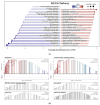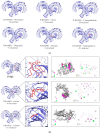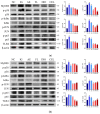Multi-Omics Unveils Inflammatory Regulation of Fermented Sini Decoction Dregs in Broilers Infected with Avian Pathogenic Escherichia coli
- PMID: 40431572
- PMCID: PMC12116022
- DOI: 10.3390/vetsci12050479
Multi-Omics Unveils Inflammatory Regulation of Fermented Sini Decoction Dregs in Broilers Infected with Avian Pathogenic Escherichia coli
Abstract
Avian colibacillosis causes significant economic losses and raises concerns for human health due to food safety risks, a problem exacerbated by the increase in antibiotic resistance. This study aimed to develop novel antibacterial strategies using fermented liquid of Sini decoction dregs to address these challenges. We analyzed the transcriptome of the chicken thymus sample GSE69014 in the GEO database to identify immune-related genes, performed molecular docking to assess compound interactions, and experimental validation via Western blot and ELISA to evaluate anti-inflammatory effects. Results revealed 11 core genes, including TLR4, critical for immune responses against the infection, with TLR4 activating key inflammatory pathways. Fermented liquid with probiotics enhanced bioactivity, and natural compounds Dioscin and Celastrol from the fermented liquid inhibited inflammation by targeting the TLR4-MD2 complex. In animal models, fermented liquid outperformed individual compounds, likely due to synergistic effects, significantly reducing inflammatory markers. These findings demonstrate that fermented liquid of Sini decoction dregs offers a promising, sustainable approach to control avian colibacillosis, mitigate antibiotic resistance, and improve poultry health, providing a scientific foundation for its application in farming to reduce economic losses and enhance food safety.
Keywords: anti-inflammatory; avian pathogenic Escherichia coli (APEC); fermented liquid of sini decoction dreg (FLSDD).
Conflict of interest statement
The authors declare no conflicts of interest.
Figures









Similar articles
-
Oral-Delivery Lactococcus lactis expressing cherry fusion lactoferrin peptides against infection of avian pathogenic Escherichia coli in chickens.Poult Sci. 2025 Jan;104(1):104637. doi: 10.1016/j.psj.2024.104637. Epub 2024 Dec 4. Poult Sci. 2025. PMID: 39662258 Free PMC article.
-
Xiaochaihu Decoction Treatment of Chicken Colibacillosis by Improving Pulmonary Inflammation and Systemic Inflammation.Pathogens. 2022 Dec 25;12(1):30. doi: 10.3390/pathogens12010030. Pathogens. 2022. PMID: 36678378 Free PMC article.
-
Peptides Affecting the Outer Membrane Lipid Asymmetry System (MlaA-OmpC/F) Reduce Avian Pathogenic Escherichia coli (APEC) Colonization in Chickens.Appl Environ Microbiol. 2021 Aug 11;87(17):e0056721. doi: 10.1128/AEM.00567-21. Epub 2021 Aug 11. Appl Environ Microbiol. 2021. PMID: 34132592 Free PMC article.
-
Avian Pathogenic Escherichia coli (APEC) in Broiler Breeders: An Overview.Pathogens. 2023 Oct 26;12(11):1280. doi: 10.3390/pathogens12111280. Pathogens. 2023. PMID: 38003745 Free PMC article. Review.
-
Colibacillosis in poultry: unravelling the molecular basis of virulence of avian pathogenic Escherichia coli in their natural hosts.Avian Pathol. 2008 Aug;37(4):355-66. doi: 10.1080/03079450802216652. Avian Pathol. 2008. PMID: 18622850 Review.
Cited by
-
Optimization of fermentation process for Sihuang compound with Bacillus subtilis and its efficacy against Escherichia coli infections and growth performance in broilers.Poult Sci. 2025 Jul 23;104(10):105588. doi: 10.1016/j.psj.2025.105588. Online ahead of print. Poult Sci. 2025. PMID: 40743629 Free PMC article.
References
-
- Yao Y., Zhang X., Wang Z., Zheng C., Li P., Huang C., Tao W., Xiao W., Wang Y., Huang L. Deciphering the combination principles of Traditional Chinese Medicine from a systems pharmacology perspective based on Ma-huang Decoction. J. Ethnopharmacol. 2013;150:619–638. doi: 10.1016/j.jep.2013.09.018. - DOI - PubMed
-
- Yuan D., Cui Y., Kou Y., Guo X., Chen B. Environmental risk and management of herbal-extraction residues induced by the composition and metal binding properties of DOM. Front. Environ. Sci. 2022;10:856308. doi: 10.3389/fenvs.2022.856308. - DOI
-
- Tao W., Jin J., Zheng Y., Li S. Current advances of resource utilization of herbal extraction residues in China. Waste Biomass Valorization. 2021;12:5853–5868. doi: 10.1007/s12649-021-01428-8. - DOI
Grants and funding
LinkOut - more resources
Full Text Sources
Miscellaneous

